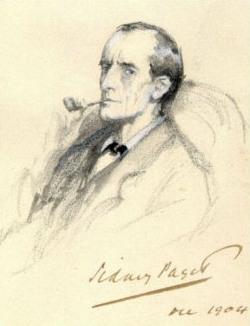Dubliners Contents
Realism and modernism
The rise of the short story after c. 1880
Short stories had always circulated as a development of the oral tradition, often communicating a moral or providing a snapshot of a character type (for example, Chaucer’s The Pardoner’s Tale). In the first half of the nineteenth century, there was greater experimentation, such as the Gothic tales of Edgar Allan Poe and dramatic incidents captured by Dickens and Scott.
However, it was in the later nineteenth century that the genre developed. With the rise of cheap print publications and periodicals, there was a huge demand for fiction that could be contained in one edition, typically between 3,000-15,000 words long.
 In Britain, Sir Arthur Conan Doyle developed the detective genre with his short stories about Sherlock Holmes, whilst Rudyard Kipling wrote moral tales for both adults and children. Meanwhile, Thomas Hardy and Henry James pursued realism with thought-provoking short stories that captured a slice of the exterior and interior life of their protagonists. Guy de Maupassant was creating similar work in France and the genre was particularly developed in Russia, by writers such as Turgenev, Tolstoy and, above all, Anton Chekhov.
In Britain, Sir Arthur Conan Doyle developed the detective genre with his short stories about Sherlock Holmes, whilst Rudyard Kipling wrote moral tales for both adults and children. Meanwhile, Thomas Hardy and Henry James pursued realism with thought-provoking short stories that captured a slice of the exterior and interior life of their protagonists. Guy de Maupassant was creating similar work in France and the genre was particularly developed in Russia, by writers such as Turgenev, Tolstoy and, above all, Anton Chekhov.
As opposed to novels, short stories frequently started in the middle of events, rather than providing significant exposition of character and situation. They captured a moment in a person’s life and/or a shift in awareness. They did not always have a ‘closed’ ending but allowed the reader to suppose what might happen next and create their own resolution. Joyce utilised all these aspects of the late nineteenth century short story when he came to compose Dubliners.
Joyce and modernism
Joyce’s later works – Ulysses (1922) and Finnegans Wake (1939) – are considered to be quintessentially modernist. Other writers considered to be modernist include Virginia Woolf, Ezra Pound, T. S. Eliot, Katherine Mansfield and Dorothy Richardson. The term modernism is used to denote literature and art which questions the status quo and experiments with new techniques and ways of representing human experience. Modernist authors often, although not always, focus on urban, rather than rural locations.
Although Dubliners is not as obviously modernist as Ulysses or Finnegans Wake, in does contain experimental elements, focuses on city life and finds new ways of representing everyday existence. For example, in The Dead, in order to give readers direct access to Gabriel’s thoughts and sensations, Joyce uses a stream of consciousness technique. This technique is closely associated with modernism and is developed further in Ulysses and in other key modernist works such as Dorothy Richardson’s Pilgrimage (1915-38).